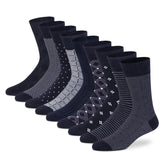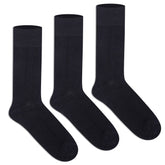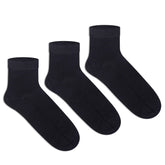Say Goodbye to Smelly Feet: A Complete Guide to Odor-Free Socks
Imagine this: You are at a friend's home and the host requests that all people take off their shoes before entering. Your heart sinks. You can imagine what is going to happen next, that familiar smell that makes everyone in the room uneasy. And in case this scenario is all too familiar, you are not alone. Research indicates that the prevalence of foot odor is almost 16 percent in adults, and millions of individuals are affected by it on a daily basis.
The great news? Stinky feet are not a death sentence. The trick is to learn the science of foot odor and choose the right anti-odor socks. This guide will take you through all that you need to know about choosing the right sports socks or modern anti-smell socks that do work. You will find out the latest technologies, realize what should be used, and why some socks are not so successful and others are.
Understanding the Science Behind Foot Odor
Why Feet Smell in the First Place
Your feet house around 250,000 sweat glands, more than any other part of your body. These glands produce moisture throughout the day, creating the perfect breeding ground for bacteria. The real culprit behind foot odor isn't sweat itself, but the bacteria that feed on it.
When bacteria break down the proteins in your sweat, they release sulfur compounds. These compounds create that distinctive, unpleasant smell we all recognize. The process accelerates in warm, moist environments, exactly what happens inside your shoes.
Most people think washing their feet more often will solve the problem. While cleanliness helps, it's only part of the solution. The bacteria return quickly, especially when your feet are trapped in the wrong type of socks.
The Sock Connection
Here's where most people go wrong. They focus on shoe quality but ignore their socks. Cotton socks absorb moisture but hold onto it, creating a damp environment all day. Synthetic materials can trap odor and prevent air circulation.
The right socks act as a barrier system. They wick moisture away from your skin, allow air to circulate, and actively fight bacteria. Without proper socks, even the most expensive shoes won't solve your odor problem.
The Technology Revolution in Sock Manufacturing
Advanced Antimicrobial Technologies
Modern sock manufacturing has evolved far beyond basic cotton knitting. Today's premium smell-less socks incorporate antimicrobial technologies that actively fight odor-causing bacteria. One breakthrough innovation is Silver Frost technology, which uses silver ions embedded in the fabric fibers.
Silver has natural antimicrobial properties that humans have used for centuries. When woven into sock fibers, silver ions create an invisible barrier against bacteria. They disrupt bacterial cell walls and prevent reproduction, stopping odor before it starts.
Clinical studies show that socks with silver-based antimicrobial treatment can reduce bacterial growth by up to 99.9%. The technology works continuously, providing protection that lasts through multiple washes. Unlike topical treatments that wear off, embedded silver ions remain active throughout the sock's lifespan.
Precision Manufacturing Matters
The manufacturing process directly impacts a sock's odor-fighting ability. Premium brands like Supersox use precision knitting machines with 96 to 240 needles, creating tight, consistent weaves that control moisture flow. This precision ensures every sock meets exact specifications for breathability and durability.
Quality control plays a crucial role, too. Leading manufacturers implement multi-stage inspection processes, checking everything from yarn quality to final packaging. They test samples every few hours during production, ensuring consistent antimicrobial effectiveness across entire batches.
Reputed brands like Supersox also use specialized machinery for processes like seamless toe construction and automated linking. These techniques eliminate bacterial hideouts that traditional sock construction methods create.
Material Science: Choosing the Right Fabric
Natural vs Synthetic Fibers
Material selection makes or breaks an odor-free sock. Mercerized cotton stands out among natural fibers for its unique properties. The mercerization process treats cotton with caustic soda, creating stronger, smoother, and more lustrous fibers. This treatment also improves the cotton's ability to accept dyes and antimicrobial treatments.
Mercerized cotton socks feel softer against the skin and maintain their shape better than regular cotton. They also provide better moisture management, drawing sweat away from feet more effectively.
Bamboo fiber offers another natural option with inherent antimicrobial properties. Bamboo naturally resists bacteria and odor, making it an excellent choice for sensitive skin. It's also incredibly soft and breathable.
Another eco-friendly option is modal socks. Modal, a regenerated cellulose fiber, is silky-smooth, highly breathable, and when combined with antimicrobial treatments, become more resistant to odor.
Synthetic blends work well when engineered properly. Modern polyester and nylon blends can outperform natural fibers in specific conditions. The key lies in the engineering, in how manufacturers combine different fibers to achieve optimal performance.
The Seamless Toe Advantage
Seamless toe construction eliminates a major bacterial breeding ground. Traditional socks have seams at the toe that create pressure points and trap moisture. These seams also provide hiding spots for bacteria to multiply.
Seamless stitching requires advanced manufacturing techniques. Machines must precisely shape the toe area without creating weak points or bulk. The result is a smooth, comfortable fit that prevents bacterial buildup and reduces hot spots that lead to increased sweating.
Design Features That Combat Odor
Ventilation and Breathability
Strategic ventilation zones make a significant difference in odor prevention. Well-designed socks incorporate mesh panels or lighter knit sections in high-sweat areas. These zones allow air to circulate while maintaining structural integrity.
Sock length also affects breathability. Ankle-length socks provide maximum air exposure but offer less coverage. Crew socks balance protection with ventilation. Knee-high socks can trap more moisture, but work well with specific antimicrobial treatments.
Moisture Management Systems
Moisture management is not merely a matter of sweating out. The most appropriate socks are made of multiple layers with the various materials performing distinct roles. The inner layers remove the moisture from the skin, whereas the outer layers facilitate rapid evaporation of moisture.
Fast drying properties avoid the sweating effect that occurs when worn over a long duration. Sophisticated synthetic materials are able to dry 3-5 times quicker than cotton, making feet comfortable all day long.
Beyond Basic Socks: Specialized Solutions
Athletic and Performance Socks
Foot odor is subjected to extreme conditions by athletic activities. An increase in activity implies increased sweat, heat, and bacterial growth. Performance socks solve these issues by utilizing a more effective antimicrobial treatment and moisture management.
Active wear is also concerned with cushioning placement. The strategic cushioning in the heel and forefoot regions avoids hot spots, which enhance sweating. Compression areas enhance the flow of blood and help avoid excess moisture.
Medical-Grade Options
Individuals who have diabetes or vascular problems require special attention. Diabetic socks are aimed at smooth compression and seamless design to avoid irritation. They also tend to include antimicrobial treatment that is based on silver because diabetics are at a greater risk of getting infections.
Compression socks also enhance blood circulation, and this prevents overheating and sweating of the feet. Medical-grade choices are tested further to make sure they are acceptable in healthcare facilities.
Climate-Specific Designs
Different climates require different approaches. Hot, humid environments need maximum breathability and moisture-wicking. Cold climates benefit from wool blends that naturally resist odor while providing insulation.
Merino wool deserves special mention for its natural antimicrobial properties. It regulates temperature in both hot and cold conditions while resisting odor development. Modern wool socks combine these benefits with synthetic fibers for improved durability.
Proper Care and Maintenance
Even the most odor-free socks require attention to ensure they remain effective. In warm water, rinse socks using antibacterial detergent. Fabric softeners should be avoided because they have the effect of coating the fibers and inhibiting the effectiveness of antimicrobials.
Antimicrobial treatments are better preserved by air drying than by high heat. When using a dryer, select the low heat setting. Silver ions and other antimicrobial substances can be destroyed by high temperatures.
Change socks when they become deformed or when they have a foul smell that cannot be removed even after washing. With normal use, the average lifespan of quality antimicrobial socks is 6-12 months, depending on the amount of activity and the level of care given to them.
Keep socks in dry and aired places. Avoid carrying the product in plastic bags or in wet places where bacteria thrive.
Real-World Testing and Quality Standards
Peace of mind can be achieved by getting a certification on your sock set. The OEKO-TEX Standard 100, say, ensures that your clothes remain free of any bad chemicals. Antimicrobial properties and durability are also claimed with other certifications.
Large brands like Supersox do not simply plaster those shiny badges on without a second thought; they work their product through the wringer. They do lab tests to demonstrate that the antimicrobial properties are indeed functioning, test the moisture-wicking ability of the fabric, and even subject the fabric to simulated wear tests to demonstrate that it will last. Customer feedback keeps the development process going and allows the teams to refine both the design and the choice of materials.
Conclusion
Foot odor can only be eliminated through the right technology, materials, and design. The new anti-smell socks have solutions that are better than the conventional methods. The trick is to realize your own needs and select socks that are designed to meet your lifestyle.
It is a bit challenging to find good, smell less socks. Check the labels that discuss the latest antimicrobial defense, and look at the manufacturing procedures, and laboratory-verified materials. Although the cost may pinch at the beginning, but just consider how good your feet and your confidence are feeling.
Want to experience the benefits of the best anti-odor socks? Explore our socks collection at Supersox. Designed with Silver Frost technology, we bring you stylish ankle-length, knee-length, no-show, and crew socks that stay fresh, clean, and odor-free even after long hours of wearing them.
FAQ
1. What makes anti-odour socks different from regular cotton socks?
Anti-odour socks are designed with antimicrobial (e.g., embedded silver ions) and moisture-wicking yarns that actually inhibit bacterial growth. Normal cotton just wicks away sweat, whereas anti-odour fabrics transport moisture and kill the microbes that produce odour.
2. Are odor-free socks safe for sensitive skin?
Yes. The majority of odor-free socks are tested dermatologically and are without harsh chemicals. Bamboo, mercerized cotton, or Modal fiber options are particularly soft and non-allergenic.
3. Can I wear anti-smell socks for intense workouts?
Absolutely. Purpose-built sports socks integrate the right amount of cushioning, ventilation panels, and antimicrobial finishes to ensure feet are left dry and fresh, even when a person is on high-sweat activities such as running or HIIT.
4. How should I wash and dry odorless socks to maintain their effectiveness?
Soak in warm water using an antibacterial (non-bleach) detergent, and do not use fabric softeners, do not machine dry. When tumble-drying is necessary, do it at low temperatures; high temperatures may destroy antimicrobial finishes.
5. Do seamless-toe designs really help with foot odor?
Yes. No pressure points and the absence of small seams where moisture and bacteria will be collected will reduce friction blisters and keep your feet cooler and drier, as well.
6. What’s the advantage of choosing Modal socks for everyday wear?
The modal fibers are very smooth, breathable, and fast drying. Modal socks are softer on the skin and remain fresher longer when used together with antimicrobial technology.
7. Are these socks available in low-cut styles for sneakers?
Definitely. Most high-end brands also sell no-show, ankle cut, men's sneaker socks with the same moisture-wicking and antimicrobial properties, but are invisible in casual shoes.
8. How often should I replace my smell-less socks?
High-quality antimicrobial socks have a life of approximately 6-12 months with routine usage and care. Discard them when elasticity disappears, the fabric gets thin, or a foul smell is left after washing.











